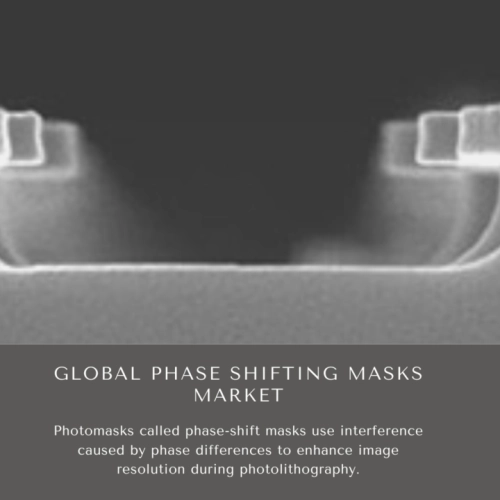
- Get in Touch with Us

Last Updated: Apr 25, 2025 | Study Period:
Photomasks called phase-shift masks use interference caused by phase differences to enhance image resolution during photolithography. Phase shift masks can be alternated and attenuated. The principle behind a phase-shift mask is that light passing through a transparent medium will experience a phase change as a function of its optical thickness.

A typical photomask is a transparent plate with uniform thickness throughout that has non-transmitting material covered in certain areas to produce a pattern on the semiconductor wafer when illuminated.
Certain transmitting zones are made thinner or thicker in alternating phase-shift masks. As a result, the light passing through specific areas of the mask experiences a phase shift (see the illustration).
When the thickness is properly chosen, the phase-shifted light's interference with the light coming from the unaltered sections of the mask has the effect of enhancing contrast on specific areas of the wafer, which may ultimately lead to an improvement in wafer resolution.
A 180-degree phase shift produces the best results since it scatters all of the incident light.However, even with modest phase changes, there is still some scattering. It can be demonstrated that a phase edge will only scatter 10% or less of the incident light for phase shifts of 37 degrees or less.
The Global phase shifting masks market accounted for $XX Billion in 2023 and is anticipated to reach $XX Billion by 2030, registering a CAGR of XX% from 2024 to 2030.
The telecommunications, sensor, and laser sectors benefit from the high quality and efficient production that Ibsen's +1/-1 order principle phase masks provide. In order to create fibre and waveguide Bragg gratings, a high-power UV laser, either an excimer laser or a frequency-doubled gas laser, illuminates the phase mask.
The necessary pitch in the fibre or waveguide is created by self-interference between the diffracted orders.
Any phase mask variation from the desired grating structure is directly transmitted to the fibre or waveguide. Therefore, the Phase mask pitch must be precise, homogeneous, and error-free. The production technique assures perfect pitch accuracy by using natural laws and scientific considerations.
Additionally, perfect homogeneity is guaranteed by geometric principles in our production equipment, which eliminates e-beam downsides like stitching mistakes and field distortion.
| Sl no | Topic |
| 1 | Market Segmentation |
| 2 | Scope of the report |
| 3 | Abbreviations |
| 4 | Research Methodology |
| 5 | Executive Summary |
| 6 | Introduction |
| 7 | Insights from Industry stakeholders |
| 8 | Cost breakdown of Product by sub-components and average profit margin |
| 9 | Disruptive innovation in the Industry |
| 10 | Technology trends in the Industry |
| 11 | Consumer trends in the industry |
| 12 | Recent Production Milestones |
| 13 | Component Manufacturing in US, EU and China |
| 14 | COVID-19 impact on overall market |
| 15 | COVID-19 impact on Production of components |
| 16 | COVID-19 impact on Point of sale |
| 17 | Market Segmentation, Dynamics and Forecast by Geography, 2024-2030 |
| 18 | Market Segmentation, Dynamics and Forecast by Product Type, 2024-2030 |
| 19 | Market Segmentation, Dynamics and Forecast by Application, 2024-2030 |
| 20 | Market Segmentation, Dynamics and Forecast by End use, 2024-2030 |
| 21 | Product installation rate by OEM, 2023 |
| 22 | Incline/Decline in Average B-2-B selling price in past 5 years |
| 23 | Competition from substitute products |
| 24 | Gross margin and average profitability of suppliers |
| 25 | New product development in past 12 months |
| 26 | M&A in past 12 months |
| 27 | Growth strategy of leading players |
| 28 | Market share of vendors, 2023 |
| 29 | Company Profiles |
| 30 | Unmet needs and opportunity for new suppliers |
| 31 | Conclusion |
| 32 | Appendix |